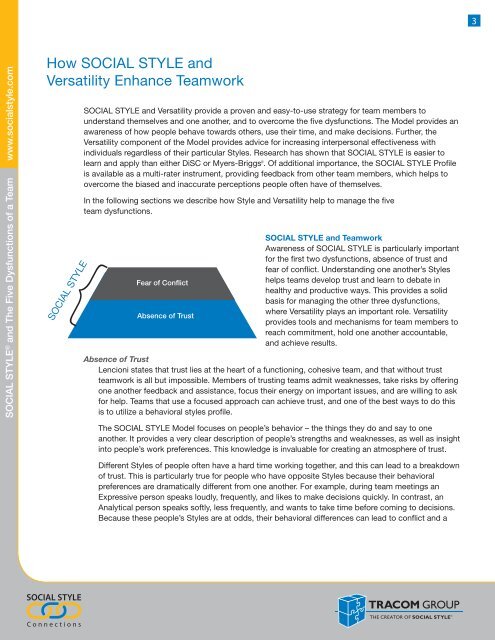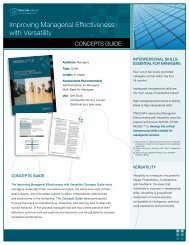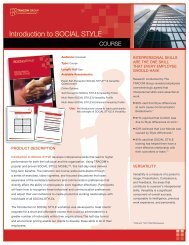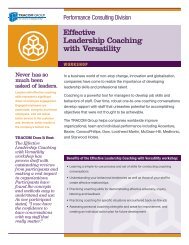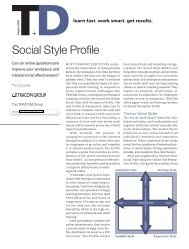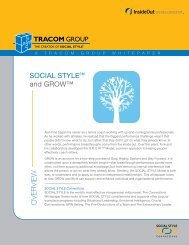Social Style and Five Dysfunctions Whitepaper - The TRACOM Group
Social Style and Five Dysfunctions Whitepaper - The TRACOM Group
Social Style and Five Dysfunctions Whitepaper - The TRACOM Group
You also want an ePaper? Increase the reach of your titles
YUMPU automatically turns print PDFs into web optimized ePapers that Google loves.
www.socialstyle.com<br />
SOCIAL STYLE ® <strong>and</strong> <strong>The</strong> <strong>Five</strong> <strong>Dysfunctions</strong> of a Team<br />
How SOCIAL STYLE <strong>and</strong><br />
Versatility Enhance Teamwork<br />
{<br />
SOCIAL STYLE<br />
SOCIAL STYLE<br />
C onnections<br />
SOCIAL STYLE <strong>and</strong> Versatility provide a proven <strong>and</strong> easy-to-use strategy for team members to<br />
underst<strong>and</strong> themselves <strong>and</strong> one another, <strong>and</strong> to overcome the five dysfunctions. <strong>The</strong> Model provides an<br />
awareness of how people behave towards others, use their time, <strong>and</strong> make decisions. Further, the<br />
Versatility component of the Model provides advice for increasing interpersonal effectiveness with<br />
individuals regardless of their particular <strong>Style</strong>s. Research has shown that SOCIAL STYLE is easier to<br />
learn <strong>and</strong> apply than either DiSC or Myers-Briggs ii . Of additional importance, the SOCIAL STYLE Profile<br />
is available as a multi-rater instrument, providing feedback from other team members, which helps to<br />
overcome the biased <strong>and</strong> inaccurate perceptions people often have of themselves.<br />
In the following sections we describe how <strong>Style</strong> <strong>and</strong> Versatility help to manage the five<br />
team dysfunctions.<br />
Fear of Conflict<br />
Absence of Trust<br />
SOCIAL STYLE <strong>and</strong> Teamwork<br />
Awareness of SOCIAL STYLE is particularly important<br />
for the first two dysfunctions, absence of trust <strong>and</strong><br />
fear of conflict. Underst<strong>and</strong>ing one another’s <strong>Style</strong>s<br />
helps teams develop trust <strong>and</strong> learn to debate in<br />
healthy <strong>and</strong> productive ways. This provides a solid<br />
basis for managing the other three dysfunctions,<br />
where Versatility plays an important role. Versatility<br />
provides tools <strong>and</strong> mechanisms for team members to<br />
reach commitment, hold one another accountable,<br />
<strong>and</strong> achieve results.<br />
Absence of Trust<br />
Lencioni states that trust lies at the heart of a functioning, cohesive team, <strong>and</strong> that without trust<br />
teamwork is all but impossible. Members of trusting teams admit weaknesses, take risks by offering<br />
one another feedback <strong>and</strong> assistance, focus their energy on important issues, <strong>and</strong> are willing to ask<br />
for help. Teams that use a focused approach can achieve trust, <strong>and</strong> one of the best ways to do this<br />
is to utilize a behavioral styles profile.<br />
<strong>The</strong> SOCIAL STYLE Model focuses on people’s behavior – the things they do <strong>and</strong> say to one<br />
another. It provides a very clear description of people’s strengths <strong>and</strong> weaknesses, as well as insight<br />
into people’s work preferences. This knowledge is invaluable for creating an atmosphere of trust.<br />
Different <strong>Style</strong>s of people often have a hard time working together, <strong>and</strong> this can lead to a breakdown<br />
of trust. This is particularly true for people who have opposite <strong>Style</strong>s because their behavioral<br />
preferences are dramatically different from one another. For example, during team meetings an<br />
Expressive person speaks loudly, frequently, <strong>and</strong> likes to make decisions quickly. In contrast, an<br />
Analytical person speaks softly, less frequently, <strong>and</strong> wants to take time before coming to decisions.<br />
Because these people’s <strong>Style</strong>s are at odds, their behavioral differences can lead to conflict <strong>and</strong> a<br />
3


